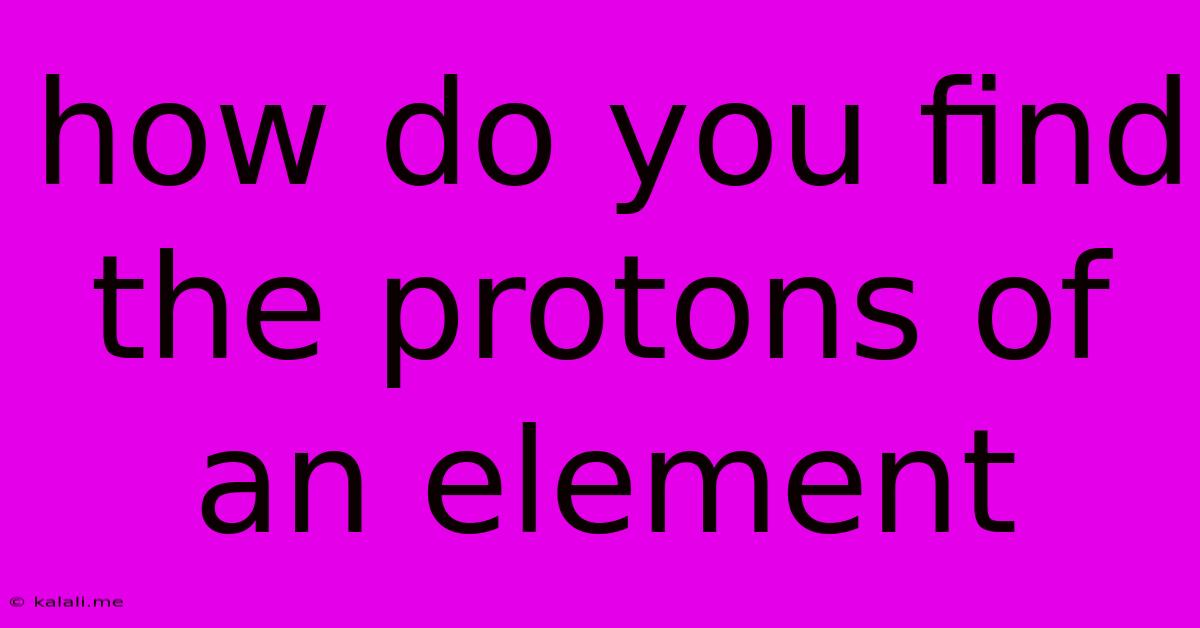How Do You Find The Protons Of An Element
Kalali
Jun 03, 2025 · 3 min read

Table of Contents
How Do You Find the Number of Protons in an Element? A Simple Guide
Determining the number of protons in an element is fundamental to understanding its identity and properties. This seemingly simple question opens the door to a deeper understanding of atomic structure and the periodic table. This article will guide you through several methods to accurately identify the proton count of any element.
Understanding the Basics: Atomic Number and Protons
The number of protons in an atom's nucleus defines its elemental identity. This number is known as the atomic number. It's a crucial characteristic that distinguishes one element from another. Unlike the number of neutrons (which can vary within an element, leading to isotopes), the number of protons remains constant for a given element. Therefore, finding the number of protons is essentially the same as finding the atomic number.
Methods to Determine the Number of Protons
Several methods allow us to determine the number of protons in an element, ranging from simple reference to more complex analysis:
-
Using the Periodic Table: The most straightforward way is by consulting the periodic table of elements. Each element is assigned a unique atomic number, which is usually displayed prominently above the element's symbol. For example, hydrogen (H) has an atomic number of 1, meaning it has one proton. Oxygen (O) has an atomic number of 8, indicating eight protons. This is the quickest and most accessible method.
-
Analyzing the Element's Symbol: Sometimes, you might encounter an element's symbol without a readily available periodic table. In such cases, you can use online resources or textbooks to locate the atomic number associated with that specific symbol. This method relies on readily available information databases and requires access to a reliable source.
-
Mass Spectrometry: For advanced applications or when dealing with unknown substances, mass spectrometry can be used. This technique measures the mass-to-charge ratio of ions. While not directly measuring protons, it provides data that allows scientists to infer the isotopic composition and ultimately deduce the atomic number (and thus, the number of protons) of the element. Mass spectrometry is a powerful tool in analytical chemistry but requires specialized equipment and expertise.
-
Nuclear Magnetic Resonance (NMR) Spectroscopy: NMR spectroscopy is another sophisticated technique providing indirect evidence about the number of protons. While it primarily analyzes the magnetic properties of atomic nuclei, the data obtained can be used to identify the element and subsequently determine its atomic number and proton count. This method is commonly used in organic chemistry and materials science for structural elucidation.
Isotopes and Proton Number
It's important to remember that isotopes of the same element have the same number of protons but differ in the number of neutrons. This variation in neutron count leads to differences in mass number, but the atomic number (and therefore the number of protons) remains unchanged. For example, carbon-12 and carbon-14 are both carbon atoms; they both have six protons, but carbon-12 has six neutrons, while carbon-14 has eight neutrons.
In conclusion, finding the number of protons in an element is typically a straightforward process, primarily achieved by referring to its atomic number on the periodic table. However, more advanced techniques like mass spectrometry and NMR spectroscopy provide alternative methods for determining this fundamental atomic property in complex scenarios. Understanding this concept is fundamental to grasping the principles of chemistry and nuclear physics.
Latest Posts
Latest Posts
-
Hot Water Heater Not Hot Enough
Jun 05, 2025
-
Should I Flush My Water Heater After 5 Years
Jun 05, 2025
-
What Does I Dont Know Mean
Jun 05, 2025
-
How Much Do U Tip A Barber
Jun 05, 2025
-
What Does Ot Mean In A Text
Jun 05, 2025
Related Post
Thank you for visiting our website which covers about How Do You Find The Protons Of An Element . We hope the information provided has been useful to you. Feel free to contact us if you have any questions or need further assistance. See you next time and don't miss to bookmark.